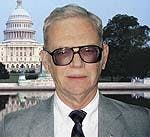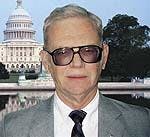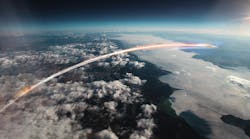John Rhea
The idea is to take out the enemy radars and surface-to- air missiles to prepare the way for manned-aircraft strikes.
WASHINGTON — The role of unmanned aerial vehicles, or UAVs, which began picking up momentum following their successful reconnaissance missions over Kosovo and Afghanistan, is evolving into the new dimension of weapons delivery.
The resulting program, now in the system demonstration phase, is the Unmanned Combat Air Vehicle (UCAV) jointly sponsored by the U.S. Air Force and the Defense Advanced Research Projects Agency (DARPA) with the Boeing Co. operation in St. Louis as the prime contractor.
As described by Thomas Lamp, the DARPA deputy program manager for UCAV at this year's Military and Aerospace Electronics Conference (including COTScon) in Baltimore, the program schedule has been accelerated and Boeing has begun selecting suppliers for the follow-on operational systems. The avionics options are currently being defined, he said, so the opportunities for the electronics industry at this moment are clear.
Lamp said he expected the program to be transferred to the Air Force in about a year and a half and that 14 of the vehicles would be fielded by Fiscal Year 2008. As currently approved, the program calls for 30 more to be delivered later. Flight tests of the X-45A (to be renamed the A-45B when it becomes operational) began in May at the Dryden Flight Research Center at Edwards Air Force Base, Calif. To date $1.3 billion has been released for acquisition, he told the conference.
Delivery of weapons is not new for UAVs; the Air Force's Predator has already done that with Hellfire missiles in Afghanistan. What is new is the all-weather strike capability of the UAV as its primary mission. The idea is to take out enemy radars and surface-to-air missiles to prepare the way for manned-aircraft strikes.
Lamp also raises the possibility that the UCAV will have an electronic countermeasures capability, a mission currently performed by manned aircraft — and one that almost certainly will increase the electronics content of the new UCAVs.
In this regard, the UCAV, with its speed of 0.8 Mach and altitude of 40,000 feet, is intended to complement the planned F-22 fighter and F-35 joint strike fighter. The UCAV is designed to operate autonomously with a single operator controlling as many as four vehicles in performance of the mission.
As with all new aircraft these days, the UCAV will feature a stealth capability, bringing stealth to "the next level," according to Lamp. The 19,000-pound gross weight vehicle will have a 3,600-pound weapons payload.
Among the critical technologies currently being evaluated are the system architectures for flight control and communications. Given the accelerated schedule of the program and the operational experience of the previous UAVs, there doesn't appear to be much opportunity here for technological innovation for the sake of technological innovation.
A parallel UAV program, the Air Force's Global Hawk, is also getting increased attention in the post-Sept. 11 environment.
As described by Paul Meyer, vice president of Northrop Grumman Corp.'s UAV operations in El Segundo, Calif., the RQ-4A Global Hawk is providing battlefield information over Afghanistan from its electro-optical and infrared sensors, synthetic aperture radar, and signals intelligence (SIGINT) sensors. Two of the unmanned aircraft have been in the theater of operations since last November.
Speaking at a news briefing in Washington in April the day after Northrop Grumman delivered the sixth air vehicle, Meyer estimated that at least 200 of the UAVs might be built to satisfy the needs of the U.S. military services and foreign military sales. The company is scheduled to deliver the seventh vehicle this fall, the last under the DARPA-sponsored advanced concept technology development (ACTD) phase, and then begin manufacturing them on conventional production lines.
With its long flight endurance — 36 hours was demonstrated last year in an autonomous flight across the Pacific to Australia — and operating altitude of 65,000 feet, Global Hawk provides an excellent platform for a variety of surveillance operations, according to Meyer.
In the visual portion of the spectrum the UAV is already providing 1-meter resolution from altitudes as high as 57,000 feet, as demonstrated last year in tests over the Dryden center.
There is a pent up need for this capability, Meyer says. The U.S. Coast Guard, for example, will be getting into the act to monitor seaborne threats as well as performing more mundane operations, such as interdiction of drug trafficking. The Navy is considering similar applications from its ships at sea.
One scenario currently being explored, according to Meyer, involves deploying Global Hawk vehicles to the island of Diego Garcia in the Indian Ocean, from which they could reach Iraq in 17 and a half hours.
Using existing Ku band military communications satellites, he claims that Global Hawk can provide data rates as fast as 274 megabits per second 24 hours a day. Military personnel on the ground can use conventional laptop computers powered by Intel 486 microprocessor chips to upload and download information.
Even NASA is getting into the act. In May officials of the space agency's Ames Research Center in Mountain View, Calif., dedicated what they call a UAV Applications Center to develop technologies for high-resolution imaging by UAVs operating in the airspace controlled by the Federal Aviation Administration.
This project will use a lightweight flying wing called the Pathfinder Plus developed at the Dryden center in cooperation with AeroVironment Inc. in Monrovia, Calif. The $3.76 million project will be the first commercial use of a solar-powered UAV operating in national airspace, according to NASA. While intended as a civilian project, it should also generate technologies applicable to military users.
What UAVs have going for them throughout this spectrum of applications, in addition to the obvious advantages of reducing the risk to human life and possibly saving some money, is their lack of human pilots. Accommodating human pilots limits maneuverability and payloads by placing restrictions on the G forces that the aircraft can sustain.
In this environment silicon semiconductors are far more survivable than their cousins on row 4 of the periodic table of elements, carbon-based life forms.




